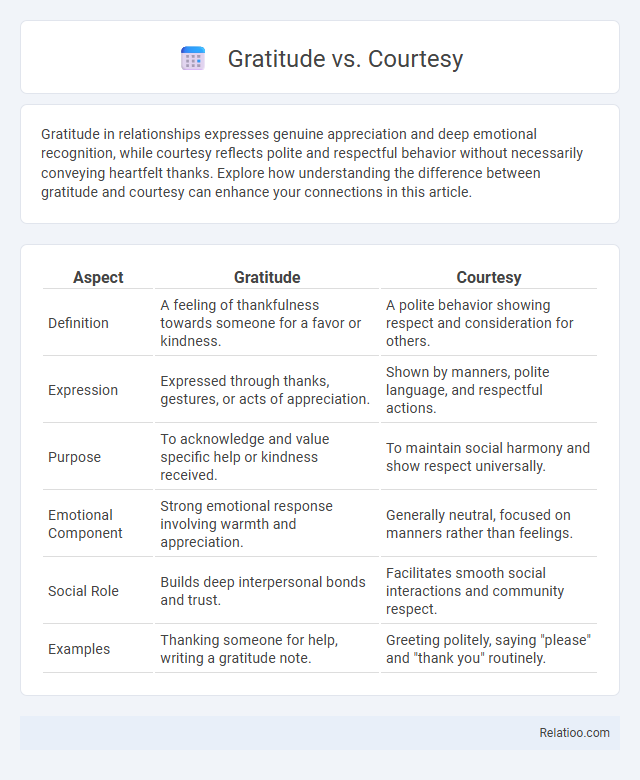Gratitude in relationships expresses genuine appreciation and deep emotional recognition, while courtesy reflects polite and respectful behavior without necessarily conveying heartfelt thanks. Explore how understanding the difference between gratitude and courtesy can enhance your connections in this article.
Table of Comparison
| Aspect | Gratitude | Courtesy |
|---|---|---|
| Definition | A feeling of thankfulness towards someone for a favor or kindness. | A polite behavior showing respect and consideration for others. |
| Expression | Expressed through thanks, gestures, or acts of appreciation. | Shown by manners, polite language, and respectful actions. |
| Purpose | To acknowledge and value specific help or kindness received. | To maintain social harmony and show respect universally. |
| Emotional Component | Strong emotional response involving warmth and appreciation. | Generally neutral, focused on manners rather than feelings. |
| Social Role | Builds deep interpersonal bonds and trust. | Facilitates smooth social interactions and community respect. |
| Examples | Thanking someone for help, writing a gratitude note. | Greeting politely, saying "please" and "thank you" routinely. |
Understanding Gratitude: Definition and Essence
Gratitude is the heartfelt recognition and appreciation of kindness or benefits received, encompassing emotions that go beyond mere acknowledgment. It involves a deep sense of thankfulness that fosters positive social bonds and personal well-being. Unlike courtesy or courteousness, which are expressions of polite behavior and manners, gratitude reflects an intrinsic emotional response and appreciation.
Courtesy Explained: Social Norms and Behaviors
Courtesy involves actions and language that adhere to established social norms, reflecting respect and consideration in interpersonal interactions. It encompasses behaviors such as polite greetings, attentive listening, and acknowledging others' presence, which foster harmonious social environments. Unlike gratitude, which expresses thankfulness for benefits received, courtesy functions as a proactive display of good manners integral to cultural etiquette.
Key Differences Between Gratitude and Courtesy
Gratitude is an emotional expression of thankfulness for kindness or benefits received, while courtesy refers to polite behavior expected in social interactions regardless of personal feelings. Gratitude personalizes appreciation by acknowledging a specific act, whereas courtesy involves general social etiquette and respectful conduct. Courteousness, as a quality, embodies consistent polite manners, but does not necessarily imply the emotional recognition that defines gratitude.
The Role of Emotion: Inner Feelings vs Outward Actions
Gratitude originates as an inner feeling of appreciation, deeply rooted in emotional recognition of kindness or benefits received, while courtesy represents outward actions that adhere to social norms and etiquette. Courteousness embodies the consistent practice of these polite behaviors, reflecting not only social harmony but also an emotional intent to respect others. The role of emotion distinguishes gratitude as an internal experience, whereas courtesy and courteousness manifest emotionally informed behaviors in social interactions.
Cultural Perspectives: Gratitude and Courtesy Around the World
Gratitude and courtesy vary widely across cultures, influencing social interactions and expectations in distinct ways. In many Asian cultures, expressing gratitude often involves formal rituals or gift-giving, while Western societies may emphasize verbal thanks or written notes; courtesy standards also differ, with some cultures prioritizing indirect politeness and others valuing directness. Understanding these cultural nuances helps you navigate interpersonal relationships more effectively, respecting local customs and fostering genuine connections.
Psychological Benefits: How Gratitude and Courtesy Affect Wellbeing
Gratitude enhances psychological wellbeing by fostering positive emotions, reducing stress, and promoting resilience through increased feelings of appreciation and connectedness. Courtesy, manifested through polite behaviors and respectful interactions, contributes to social harmony and reduces interpersonal conflicts, thereby supporting emotional stability. Courteousness as a consistent behavioral trait encourages trust and mutual respect, which strengthens social bonds and improves overall mental health.
Social Impact: Building Relationships with Gratitude and Courtesy
Gratitude fosters genuine appreciation that strengthens your relationships by creating emotional bonds and trust. Courtesy reflects respectful behaviors that promote positive social interactions and smooth communication within communities. Courteousness, the consistent practice of polite actions, enhances social harmony and helps build a supportive network for lasting connections.
Expressions in Daily Life: Practical Examples and Scenarios
Expressions of gratitude often involve thanking someone verbally or with a written note, showing appreciation for acts of kindness, while courtesy includes polite behaviors such as holding doors open or using polite language like "please" and "thank you." Courteousness reflects a consistent attitude of respect and consideration in daily interactions, such as listening attentively during conversations or offering help without being asked. Your ability to distinguish and practice these expressions enhances social harmony and strengthens personal and professional relationships.
Fostering Genuine Gratitude Over Habitual Courtesy
Fostering genuine gratitude involves recognizing and appreciating the deeper value behind actions beyond mere habitual courtesy, which is often performed out of social obligation. Your expressions of gratitude reflect authentic acknowledgment of kindness and create stronger emotional connections than routine gestures of courtesy. Cultivating this sincerity encourages meaningful interactions that resonate more profoundly than standard polite behavior.
Integrating Gratitude and Courtesy for a Better Society
Integrating gratitude and courtesy fosters stronger social bonds and promotes mutual respect, creating a more harmonious community. Your expressions of gratitude acknowledge kindness, while consistent courteous behavior upholds social norms and enhances positive interactions. Cultivating both qualities leads to a more empathetic and cooperative society, benefiting everyone involved.

Infographic: Gratitude vs Courtesy
 relatioo.com
relatioo.com